Click below to jump to an article of interest.
SHALLOW LIGHTNING, MUSHBALLS AT JUPITER
New results from the Juno mission at Jupiter suggest our Solar System’s largest planet is home to “shallow lightning.” The unexpected shallow depth of the electrical discharges indicates an origin from clouds containing an ammonia-water solution, rather than water clouds that drive Earth’s lightning. The findings are coupled to a new theory explaining why Juno found so little ammonia in the gas giant’s upper atmosphere. Scientists suggest that ammonia-rich hailstones, called “mushballs,” are produced by Jupiter’s violent thunderstorms, which essentially kidnap ammonia and water in the upper atmosphere and carry them down into the deep atmosphere.
These findings coupled with new analysis from Juno’s microwave radiometer suggest the gas giant’s violent thunderstorms may produce slushy ammonia-rich hailstones the team calls “mushballs.” The scientists theorize that these mushballs essentially kidnap ammonia and water in the upper atmosphere and carry them down to Jupiter’s depths. Since NASA’s Voyager mission first saw Jovian lightning flashes in 1979, most scientists thought the planet’s lightning was similar to Earth’s, occurring only in thunderstorms where water exists in all its phases — ice, liquid and gas. Voyager saw lightning as bright spots on Jupiter’s cloud tops, suggesting that the flashes originated in deep water clouds. But lightning flashes observed on Jupiter’s dark side by Juno’s Stellar Reference Unit tell a different story.
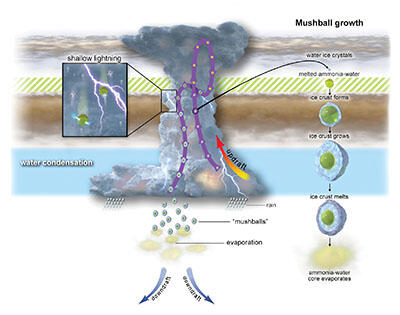
Courtesy of NASA/JPL-CALTECH/SwRI/MSSS/CNRS/Gerald Eichstädt/Heidi N. Becker/Koji Kuramura
The graphic above depicts the evolutionary process of “shallow lightning” and “mushballs” on Jupiter. The illustration at right uses data obtained by NASA’s Juno mission to depict high-altitude electrical storms on Jupiter. Juno’s sensitive Stellar Reference Unit camera detected unusual lightning flashes on Jupiter’s dark side during the spacecraft’s close flybys of the planet.
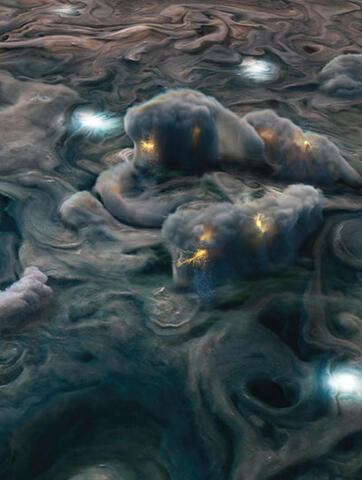
“Juno’s close flybys of the cloud tops allowed us to see something surprising — smaller, shallower flashes originating at much higher altitudes in Jupiter’s atmosphere than previously assumed possible,” said Dr. Heidi Becker, Juno’s Radiation Monitoring Investigation lead at NASA’s Jet Propulsion Laboratory and the lead author of a Nature paper outlining these results.
The findings suggest that Jupiter’s powerful thunderstorms fling water-ice crystals high into the planet’s atmosphere, where they encounter atmospheric ammonia vapor that melts the ice, forming an ammonia-water cloud, with the ammonia acting as antifreeze. Falling droplets of ammonia-water liquid collide with the upgoing water-ice crystals and electrify the clouds, creating shallow lightning.
The phenomena provide clues that solve another mystery about the workings of Jupiter’s deep atmosphere. Juno’s microwave radiometer instrument found large-scale depletion of ammonia in Jupiter’s atmosphere, and, even more puzzling, the amount of ammonia varies at deep depths from place to place around the planet.
“Previously, scientists realized there were small pockets of ‘missing’ ammonia, but no one realized how deep these pockets went or that the depletion covered most of Jupiter,” said SwRI’s Dr. Scott Bolton, Juno’s principal investigator. “We were struggling to explain the depth of the ammonia depletion by rain-out when I realized a solid piece of hail might go much deeper and take up more ammonia. When Heidi discovered shallow lightning, I realized we had evidence that ammonia must be mixing with water high in the atmosphere.”
A strange brew of two-thirds water and one-third ammonia gas is the likely seed for the Jovian mushballs. Consisting of layers of waterammonia slush and ice covered by a thicker water-ice crust, mushballs are generated in a similar manner as hail is formed on Earth — by growing larger as they move up and down through the atmosphere. Once mushballs reach a certain size, they fall deep into the atmosphere, dragging ammonia and water deep into the planet’s atmosphere.
“Combining these two results was critical to solving the mystery of Jupiter’s missing ammonia,” said Bolton. “As it turned out, the ammonia isn’t actually missing; it is just transported down while in disguise, having cloaked itself by mixing with water. The theory is very simple and elegant: When the water and ammonia are in a liquid state, they are invisible to us until they reach a depth where they evaporate — and that is quite deep.”
The shallow-lightning findings were published in the Aug. 6 issue of the journal Nature, while the mushballs research is available online in the Journal of Geophysical Research: Planets.
Learn more at Planetary Science.
SwRI, UTSA CONNECT Through Research
The University of Texas at San Antonio and SwRI are collaborating to understand hypersonic flight environments and reduce the costs of malaria treatments. The two research projects are supported by \$125,000 grants from the SwRI-UTSA Connecting through Research Partnerships (CONNECT) Program.
The program is sponsored by the Executive Office at SwRI and the Office of the Vice President for Research, Economic Development, and Knowledge Enterprise at UTSA. CONNECT grants enhance greater scientific collaboration between the two institutions and increase both UTSA’s and SwRI’s research funding with cross-campus programs.
HYPERSONIC FLIGHT
Dr. Nicholas J. Mueschke of SwRI’s Mechanical Engineering Division and Dr. Christopher Combs of UTSA’s College of Engineering are leading the project to develop unobtrusive diagnostics for hypersonic flight testing. “The goal is to ultimately make full aerodynamic measurements in a truly representative hypersonic environment,” Mueschke said. “These measurements will directly contribute to the design of next-generation hypersonic vehicles.”
Hypersonic speed is defined as faster than five times the speed of sound, or greater than Mach 5. When something is flying that fast, the air moving around the object will chemically decompose. Some points behind the shockwave created by the vehicle are hotter than the surface of the sun. This strange environment causes whatever is traveling through it to heat up, and even melt and chemically react with the air.
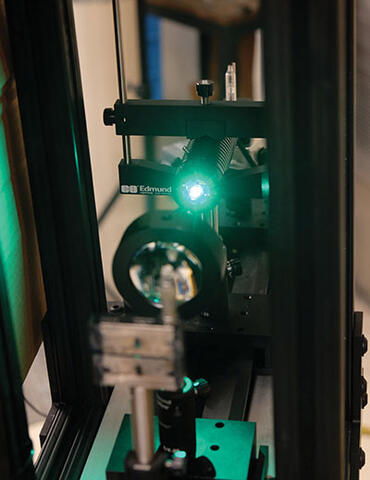
SwRI and UTSA are developing new laser-based techniques to study the extreme environment around a hypersonic flight body.
Mueschke has researched the hypersonic environment extensively at SwRI using the Institute’s two-stage light-gas gun system, which simulates hypersonic flight conditions and allows researchers to image objects in hypersonic flight.
By pointing a laser at just the right wavelength at the airflow around a hypersonic vehicle, certain molecules absorb the light briefly and then emit it in different colors, a process known as laser-induced fluorescence. Engineers determine how fast the molecules are moving by taking image after image of the emitted light as it moves.
This technique is significant, because intrusive velocity sensors would interfere with the airflow and flight environment. For the scale of the objects under test, the most relevant action is happening within a millimeter of the surface of the object in motion. Mueschke and Combs hope to determine the environment’s pressure, temperature and density, to create a representative picture of the mysterious hypersonic flight environment.
“Hypersonic flight generally refers to speeds faster than five times the speed of sound, which is roughly 4,000 mph,” Combs said. “At this speed it would take less than an hour to fly from New York to Los Angeles, and you could get from San Antonio to just about anywhere in the continental U.S., in less than 30 minutes. There’s potential to truly revolutionize how we get from place to place. Add in the fact that all spacecraft return to Earth at hypersonic speeds, along with the obvious defense applications, and you can see why hypersonics is a particularly hot topic right now.”
Mueschke and Combs will make their initial measurements at Combs’ laboratory at UTSA, which will soon include a Mach 7 Ludwieg Tube, a facility that can mimic some conditions of hypersonic flight. In later stages, the experiments will move to SwRI’s two-stage light-gas gun system, which more closely simulates the hypersonic flight environment.*
MALARIA DRUGS
Shawn Blumberg of SwRI’s Chemistry and Chemical Engineering Division and Dr. Doug Frantz of the Department of Chemistry within UTSA’s College of Sciences are leading the second CONNECT project. They are developing techniques to synthesize highly potent derivatives of the antimalarial drug artemisinin to create a more powerful, cost-effective malaria treatment.
In 2018, Blumberg and Frantz collaborated in a project funded by the Bill & Melinda Gates Foundation to create a more efficient way to synthesize artemisinin, a drug derived from the sweet wormwood plant, Artemisia annua. While artemisinin is considered the most effective treatment for malaria, the mosquito-borne parasitic infection is becoming harder to battle as it becomes increasingly resistant to drugs like artemisinin.

UTSA and SwRI are collaborating to synthesize a less expensive and more potent drug to treat malaria, one of the world’s deadliest mosquito-borne diseases.
“Malaria affects 200 million people every year and kills close to 400 thousand people, making it one of the world’s deadliest infectious diseases,” Blumberg said. “Unfortunately, the countries that have the highest incidence of malaria also tend to have lower resources and are significantly burdened by the cost of current and newer treatments.”
Most artemisinin is still made from Artemisia annua, but this process is time-consuming, and crop yields are susceptible to weather patterns, insects and other factors. A newer semisynthetic development method involves inserting the plant’s genes into a microorganism to produce an intermediate compound used to make artemisinin.
“Dr. Frantz and I were able to create artemisinic acid, which is the direct precursor to artemisinin,” Blumberg said. Now, the two researchers are following up on their previous work by revisiting the pioneering work of Dr. Mitchell Avery at The University of Mississippi in the 1990s.
“Using the chemical technology that we developed, we can pivot the artemisinin synthesis to produce the same highly potent artemisinin derivatives that had previously been studied by Dr. Avery nearly 30 years ago,” Blumberg said. “He was able to make several ultra-potent derivatives from various compounds, but it took multiple complex steps to accomplish that.”
Using the much simpler synthesis technique created by Blumberg and Frantz, they plan to revisit these potent artemisinin derivatives to address the growing drug resistance in a cost-effective manner.
“Our combined expertise in synthetic chemistry and drug discovery will allow us to accelerate our discoveries at the bench into tangible bedside treatments for this devastating disease,” Frantz said.
See Hypersonics feature story.
Laser Coating Removal Robot Wins R&D 100 Award
Stripping paint and other coatings from full-body aircraft is required multiple times over the course of an aircraft’s lifespan. Traditional coating removal processes are costly, timeconsuming and potentially hazardous to workers and the environment. An efficient, robot-guided laser developed by Southwest Research Institute and XYREC is revolutionizing that.
The laser coating removal (LCR) robot, recognized by R&D World magazine as one of the 100 most significant innovations of 2020, is the only robotic aircraft coating removal process that can cover the full range of aircraft sizes, coatings, colors and substrates on a broad range of defense and commercial aircraft, from fighter jets and helicopters to cargo planes.
“The technology is unique, fast and more environmentally friendly than traditional processes,” said Paul Evans, Director of SwRI’s Manufacturing and Robotics Technologies Department. “LCR uses the largest specialized commercially available CO2 laser on the largest mobile manipulator to accurately control the coating removal process.”
Controlled by a proprietary computer vision system with a patented polygon scanner, the robot uses a CO2 laser to combust and ablate paint. Effluent is immediately vacuumed from the surface and filtered.
A built-in, closed-loop, color recognition and control system allows it to strip both metal and composite surfaces accurately, making selective stripping possible. Software guides the robot, allowing LCR to closely follow the three-dimensional contour of an aircraft. The fully autonomous system can be managed by a single operator and can work independently or in tandem with another LCR.
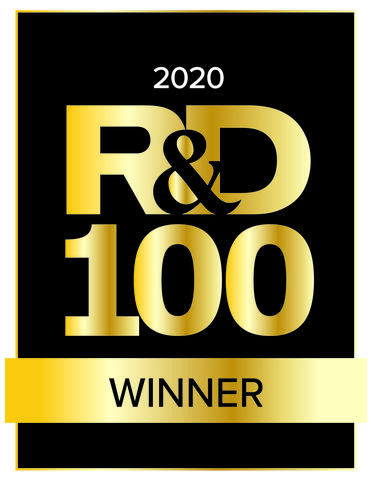
“Coating removal is a critical and necessary operation needed for all aircraft at multiple times over their service life,” said Steve Dellenback, vice president of SwRI’s Intelligent Systems Division. “We worked closely with XYREC engineers to develop this innovative system.”
The LCR system is faster than traditional processes, and testing has shown a drastic reduction in costs per aircraft, while minimizing reliance on support facilities and reducing aircraft downtime. It is compatible with all types of aircraft and helicopters and can also remove coatings from a range of off-airframe parts.
“We are committed to continuously improving the world around us through innovation,” said SwRI President and CEO Adam L. Hamilton, P.E. “It’s an honor to see the Institute recognized for those efforts at what’s widely known as the ‘Oscars of Innovation.’”
The R&D 100 Awards are among the most prestigious innovation awards programs, honoring the top 100 revolutionary technologies each year since 1963. Recipients hail from research institutions, academic and government laboratories, Fortune 500 companies and smaller organizations. Since 1971, SwRI has won 47 R&D 100 Awards, including another 2020 award for the SPARTA system.
Learn more at the Innovations in Automation Blog.
SLED Tackles New Challenges
SwRI is continuing to develop new applications for its Smart Leak Detection system (SLED), which autonomously finds liquid and gaseous leaks of hazardous materials. The award-winning SLED technology collects inputs from low-cost optical sensors and applies machine learning techniques to reliably detect the chemical “fingerprint” of methane gas escaping from pipelines as well as liquid leaks on solid surfaces such as soil, gravel, sand and now water.
QUANTIFYING METHANE LEAKS
SwRI is continuing the development of SLED/M technology to quantify fugitive methane emissions through a project funded by DOE’s Office of Fossil Energy and managed at the National Energy Technology Laboratory (NETL).
SwRI developed SLED/M to accurately detect small methane leaks that typically go unnoticed along natural gas pipelines and in compressor stations. Over the next year, SwRI will enhance the algorithms to quantify these leaks, adding a low-cost longwave infrared thermal imager and a lightweight lidar (light detection and ranging) system to the existing midwave infrared thermal imager. Natural gas leaks are typically measured from a single point using a diode laser absorption spectroscopy instrument, which must be moved to several positions to gather data.
“Conventional methods can be costly and time-consuming, and they often fail to pinpoint leak sources,” said Heath Spidle, SwRI project lead. “This new technology will enhance SLED/M’s proven methane detection algorithms with a physics model using 3D visuals to measure the volume of fugitive methane emissions.”
The DOE is particularly interested in developing scalable quantification technologies, partly in response to a recent Stanford study that found only one in nine methane detection technologies are reliable.
“This newly added task will continue the important research being done at SwRI,” said Joe Renk, the DOE NETL senior federal project manager overseeing the work. “The use of gas imagers and lidar with machine learning presents an opportunity to develop cost-effective solutions to accurately quantify natural gas flow rates.”
SLED/W FINDS OIL ON WATER
SwRI is using internal funding to expand SLED to find leaks on water. With over 80,000 miles of oil pipelines across the United States, many waterways are at risk for environmental damage from incidents such as the 2010 Kalamazoo Spill, which cost more than $1.2 billion and took three years to clean up. Monitoring waterways near oil pipelines is costly and time-consuming using conventional solutions that rely on satellite remote sensing or laser spectroscopy.
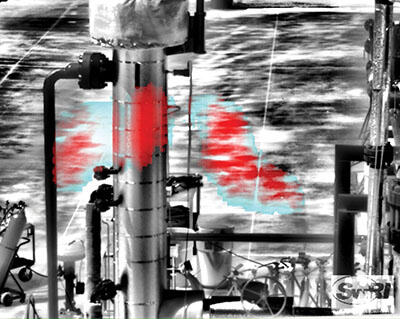
SwRI will quantify fugitive methane flow rates using machine learning, thermal imaging and lidar technology. A midwave infrared imager captured this methane plume (red and blue).
SwRI addresses these challenges with a SLED/Water system, which uses algorithms to process data from visual and thermal cameras affixed to aircraft, stationary devices or watercraft. This machine learning-based solution can detect and monitor oil leaks before they become major threats to lakes, rivers and coastal areas.
“SLED/W was able to detect two different types of oil with unique thermal and visible properties,” said Ryan McBee, who led the project. “SLED/W showed positive initial results, and with further data collection, the algorithm will handle more varied external conditions.”
SwRI applied a multidisciplinary approach to develop SLED/W. Computer scientists teamed with oil and gas experts from the Institute’s Mechanical Engineering Division to train algorithms to recognize the unique characteristics of oil on water. For example, oil can spread over water or blend with it, making it difficult for sensors to discern under various lighting and environmental conditions.
By combining thermal and visible cameras, SLED/W analyzes scenes from different perspectives. Visible cameras are limited by glare and have difficulty capturing transparent thin oils that blend with water. Thermal vision requires heat differences to discern features, which lead to false positives near animals and other warm objects. By combining thermal and visual images into the machine learning system, algorithms can choose the most relevant information, mitigating the weaknesses of each sensor.
Learn more at Methane Leak Detection.
SwRI to Develop Space Weather Instruments
NASA, on behalf of the National Oceanic and Atmospheric Administration (NOAA), recently awarded SwRI two contracts to develop a magnetometer and a solar wind plasma sensor for a satellite mission dedicated to tracking space weather. Both instruments are part of the satellite’s solar wind instrument suite, which measures the characteristics of the solar wind plasma that interacts with the Earth’s geomagnetic environment.
“The satellite will collect solar wind data and coronal imagery to support NOAA’s mission to monitor and forecast space weather events,” said Dr. Roy Torbert, a program director in SwRI’s Earth, Oceans and Space Department at the University of New Hampshire in Durham and principal investigator of the magnetometer. “Space weather refers to the variable conditions on the Sun and in space that can influence the performance of technology we use on Earth, such as electrical power grids, and disrupt satellite-based communication and navigation systems.”
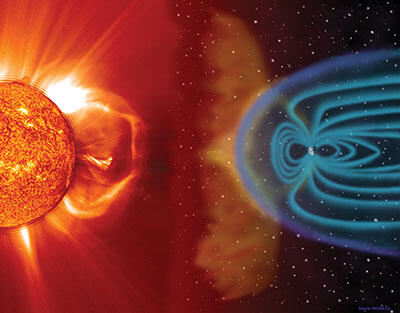
Courtesy of NASA
Scheduled to launch in 2024, the Space Weather Follow-On Lagrange 1 (SWFO-L1) satellite will orbit the Sun at approximately 1.5 million kilometers from Earth, a point known as L1. Instruments onboard the satellite will make local measurements of the solar wind thermal plasma and magnetic field. It also carries a compact coronagraph instrument to detect coronal mass ejections and an instrument to measure high-energy particles. SWFO-MAG
“The magnetometer instrument, known as SWFO-MAG, provides key data about the solar wind as it approaches Earth,” Torbert said. “The data will be available to the science community but are targeted to the Space Weather Prediction Center.”
SwRI will work with UNH to design, develop, fabricate, integrate, calibrate and evaluate the magnetometer. The team will also support launch and on-orbit check-out of the instrument, supply and maintain the instrument’s ground support equipment and support NOAA’s mission operations center as needed. SWFO-MAG includes two three-axis magnetometers and associated electronics to measure the vector interplanetary magnetic field. SWiPS
“The Solar Wind Plasma Sensor (SWiPS) is based on the Ion and Electron Sensor flown on ESA’s comet mission, Rosetta,” said Dr. Robert Ebert, an SwRI principal scientist and SWiPS principal investigator. “The compact design, low resource requirements and ideal data production make this a well-suited instrument for the SWFO-L1 mission.”
A traditional strength of SwRI’s Space Science and Engineering Division is the design and fabrication of instruments for the in-situ measurement of space plasmas. These dilute ionized gases populate the immediate space environments of the Earth and other Solar System bodies as well as interplanetary space.
NASA is planning to launch SWFO-L1 in 2024 as a rideshare with the Interstellar Mapping and Acceleration Probe (IMAP) mission. SwRI also plays a key role in that mission, managing the payload and providing scientific instruments to help analyze and map particles streaming from the edge of interstellar space and to help understand particle acceleration near Earth.
Learn more at Heliophysics.
Developing High-Latitude Mission to the Sun’s Poles
SwRI also contributing to two additional mission concept design studies
An SwRI proposal to study the Sun’s poles — considered among the last unexplored regions of the Solar System —is one of five science investigations selected as a possible future NASA mission.
Dr. Don Hassler, a program director at SwRI’s Boulder office, is the principal investigator for Solaris. This proposed solar polar Medium-Class Explorers (MIDEX) mission could revolutionize our understanding of the Sun by addressing fundamental questions that can only be answered from a polar vantage point. NASA has approved a \$1.25 million, nine-month contract for Phase A concept design studies and analyses to develop the mission that would visit this region for the first time since the 1990s.
“Solaris would explore one of the last unseen places in the Solar System, the poles of the Sun,” Hassler said. “The Ulysses spacecraft visited the region but did not have remote sensing instruments onboard to probe the Sun’s polar magnetic field or surface/ subsurface flows.”
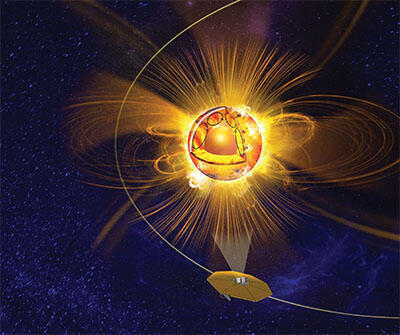
To get to the Sun’s poles, Solaris would first travel to Jupiter and use Jupiter’s gravity to slingshot out of the ecliptic plane and fly over the Sun’s poles at 75 degrees latitude. Imaging the poles of the Sun from such high latitude promises to reveal clues to understanding how the Sun’s polar magnetic fields and flows shape the solar activity cycle.
“Solaris would spend more than three months over each pole of the Sun, obtaining the first continuous, high-latitude, months-long studies of the Sun’s polar regions,” said Hassler. “With focused science and a simple, elegant mission design, Solaris would also provide enabling observations for space weather research, such as the first polar views of coronal mass ejections, energetic events that spew highly magnetized plasma from the solar corona into space, causing radio and magnetic disturbances on the Earth.”
The proposed spacecraft would be provided by Ball Aerospace, and the payload is expected to include a compact Doppler magnetograph to study the polar magnetic fields and subsurface flows, a white light coronagraph to image the solar corona from the poles, and an extreme ultraviolet instrument to image the million degree solar surface of the poles.
SwRI also supports two other missions funded for Phase A concept design studies, the Auroral Reconstruction CubeSwarm (ARCS) and the Solar-Terrestrial Observer for the Response of the Magnetosphere (STORM) mission proposals. SwRI would manage the ARCS mission for the principal investigator, Dartmouth Professor Kristina Lynch, and provide a solar wind instrument for the STORM mission, led by David Sibec of the Goddard Space Flight Center.
ARCS proposes to explore the processes that contribute to auroras at size scales that have been rarely studied — at the intermediate scale between the smaller, local phenomena leading directly to the visible aurora and the larger, global dynamics of the space weather system coursing through the Earth’s ionosphere and thermosphere. The mission would deploy an innovative, distributed set of sensors via 32 CubeSats and 32 ground-based observatories to provide a comprehensive picture of the drivers and response of the auroral system.
For STORM, SwRI would provide a next generation of the Ion and Electron Sensor that flew on the Rosetta mission. This mission would provide the first-ever global view of our vast space weather system in which the constant flow of particles from the Sun — known as the solar wind — interacts with Earth’s magnetosphere and improve our ability to forecast the harmful effects of this interaction on society and technological infrastructure.
SwRI ROBOTIC SYSTEM INSPECTS TIGHT SPOT
SwRI has been awarded a \$1.3 million project from Washington River Protection Solutions (WRPS), a contractor to the U.S. Department of Energy (DOE), to build a robotic system to inspect the bottoms of massive underground double-shell tanks at the Hanford Site. The design phase of the project was completed in 2019.
The site stores chemical and radioactive waste in million-gallon tanks that hold waste in an inner vessel encased in a secondary shell to further protect the surrounding environment. The tanks must be inspected regularly, but there are no commercially available technologies for inspecting the vessel bottoms due to access restrictions.
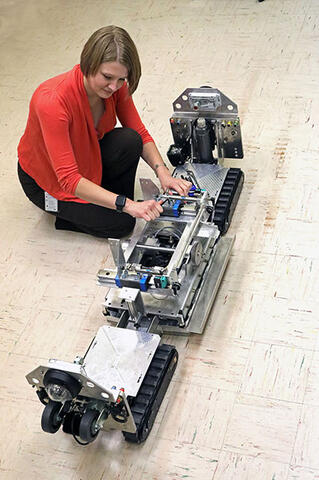
“The biggest challenge for inspection is the bottom of these vessels,” said Dr. Adam Cobb, an SwRI principal engineer. “While WRPS performs visual and ultrasonic inspection of the accessible portions of the vessels, our tool is unique in that it uses ultrasonic guided waves. Our sensor is placed in an accessible location, and we are able to inspect the bottoms of the vessels where there is no direct access.”
The guided wave sensor is paired with a robotic delivery system to position the sensor within the harsh environment. The robotic inspection system is designed to identify flaws in the carbon-steel tanks while operating in the 30-inch space between the primary and secondary vessels.
“Our robotic inspection system uses SwRI-developed guided wave inspection technology to nondestructively find defects in the metal so mitigation steps can be taken,” Cobb said. “Sound waves travel down the primary wall into the vessel bottom; the inspection system listens for the sound waves to reflect from any damage, such as cracks or corrosion.”
The robot housing the system is five feet long but narrow, allowing it to be lowered into the space between the primary and secondary tanks and then expanded to perform the inspection.
Construction of the inspection system is underway, with delivery planned for early 2021.
Characterizing Near-Earth Asteroids
An SwRI scientist is helping NASA observe and characterize near-Earth objects (NEOs) that could pose a threat to Earth or have potential for further exploration. Dr. Tracy Becker is part of an international team of scientists using data from the Arecibo Observatory in Puerto Rico to study nearby asteroids and comets through a \$19 million grant managed by the University of Central Florida (UCF).
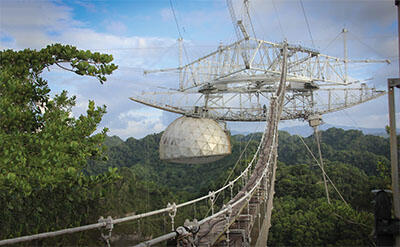
Courtesy of JUAN.ALCAIDE231/CC BY-SA 4.0
“We are looking at the trajectory, spin, shape, mass, composition and size of NEOS, which allows us to look forward in time and understand if they pose a future impact risk to Earth,” said Becker, a co-investigator on the project. “The idea is that if an impact hazard is discovered far enough in advance, you can potentially avert that risk, perhaps by nudging the asteroid’s orbit to a safer distance.” Arecibo is home to one of the most powerful and sensitive radio telescopes in the world. The active radar system emits a radio signal toward its target and receives the reflected radio waves back using spherical dishes to characterize these relatively small objects.
In 2005, Congress prioritized this type of research, directing NASA to find and characterize at least 90 percent of near-Earth objects larger than 150 yards in diameter — about 50 percent larger than a football field — by 2020.
“The data are also significant for identifying asteroids that may be of interest for future exploration,” Becker said. “For example, Arecibo did a great job of characterizing asteroid Bennu, data critical to NASA’s OSIRIS-REx mission, which will collect a sample from the asteroid’s surface this year. There’s even interest in mining useful resources available on these objects, but we have to know a lot more about them.”
Targeting Stellar Phosphorus for Life
An SwRI scientist has identified stellar phosphorus as a probable marker in narrowing the search for life in the cosmos. She has developed techniques to identify stars likely to host exoplanets, based on the composition of stars known to have planets, and proposes that upcoming studies target stellar phosphorus to find systems with the greatest probability for hosting life as we know it.
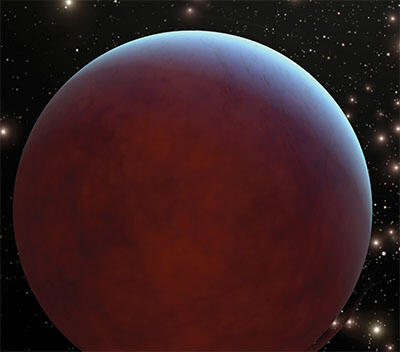
Courtesy of NASA/JPL-CALTECH
“When searching for exoplanets and trying to see whether they are habitable, it’s important that a planet be alive with active cycles, volcanoes and plate tectonics,” said SwRI’s Dr. Natalie Hinkel, a planetary astrophysicist and lead author of a new paper about this research in the Astrophysical Research Letters. “My coauthor, Dr. Hilairy Hartnett, is an oceanographer and pointed out that phosphorus is vital for all life on Earth.”
Current technology cannot measure the composition of exoplanets, but it’s generally assumed that their compositions mirror those of their host stars. Scientists can measure the abundance of elements in a star spectroscopically and can infer what a star’s orbiting planets are made of using the stellar composition as a proxy. But there’s very little stellar phosphorus abundance data because it’s detected in a region of the light spectrum not typically observed: at the edge of the optical (or visual) wavelengths of light and infrared light.
“Our Sun has relatively high phosphorus and Earth biology requires a small, but noticeable, amount of the element,” Hinkel continued. “So, on rocky planets that form around host stars with less phosphorus, it’s likely that the element will not be available for potential life on that planet’s surface. Therefore, we urge the stellar abundance community to make phosphorus observations a priority in future studies and telescope designs.”
Major Updates to NPSS Software
SwRI has released a new, updated version of the Numerical Propulsion System Simulation (NPSS®) software. NPSS has a new user-friendly interface that reduces the amount of time needed to learn the software, and new functions streamline the design process.
Engineers use this design and simulation tool to model rocket engines, jet engines, turbomachinery, environmental control systems, advanced power cycles including supercritical carbon dioxide (sCO2) cycles and other technologies beneficial to the aerospace and energy industries.
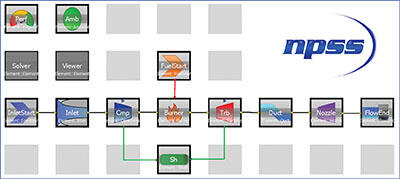
“NPSS has always been an excellent tool for engineers and developers,” said Charles Krouse, an SwRI group leader. “This new version introduces several new features that improve usability, including an integrated development environment, updated user guides and new example models.”
Developed in the 1990s by the NASA Glenn Research Center, NPSS has become the leading aerospace software package for simulating and designing propulsion systems. SwRI has managed the NPSS Consortium since 2013, supporting the NPSS user community with new software capabilities, improved usability and technical support. Key features of NPSS include a standard library of thermodynamic databases, standard elements for engine cycle models, example engine models, interfacing examples, completely customizable elements and a robust solver.
“We also updated the NPSS library of element, model and interface examples,” Krouse said.
The updated software is licensed through SwRI and available on its NPSS webpage. The new NPSS integrated development environment, NPSS IDE, provides an intuitive modeling environment without sacrificing the versatility of NPSS. IDE helps users develop, interrogate and run models, as well as view results.
Learn more at Numerical Propulsion System Simulation (NPSS).
Characterizing a Trans-Neptunian Binary Locked in a Tight Orbit
SwRI scientists collaborated with a network of citizen scientists to characterize the close binary nature of a trans- Neptunian object (TNO). This population of small icy bodies — which includes Kuiper Belt, scattered disc and detached objects — orbit the Sun at a greater average distance than Neptune.
Binary TNOs occur when two of these objects orbit each other as they circle the Sun. Rodrigo Leiva and Marc Buie discovered this TNO in a particularly close gravitational configuration using stellar occultation. When an object passes between Earth and a distant star, it hides, or “occults,” the star from view. Observers located in the path of the object’s shadow can record the star blinking out and reappearing.
“In this instance, the occulted star also turned out to be a binary system. Binary stars are not unusual and binary objects are not unusual,” Buie said. “But it is unusual that we had a binary TNO occulting a binary star.”
The discovery of the new TNO was made possible by the Research and Education Collaborative Occultation Network (RECON), a collection of 56 observation stations stretching from Yuma, Arizona, to Orville, Washington. The NSF-funded project provides each station with an array of observation equipment, including 11-inch telescopes. Trained high school teachers and their students make the observations.
The TNO’s two components are only 350 kilometers (217 miles) apart. The majority of observed binary TNOs are separated by 1,000 kilometers or more. Most Solar System models indicate that binaries are very common, particularly close binaries such as this one, but they can be difficult to characterize.
“Our overarching aim is to know how common close binary TNOs are,” Buie said. “Is this object one in a million or just like 90% of them? This is fueling our knowledge for building better models of how the Solar System formed.”
Send in the Drones
SwRI is offering new drone-based, remote-sensing techniques to digitally map and model exposed geologic structures, or outcrops, to better understand subsurface structures associated with petroleum and water reservoirs. Through digital photogrammetry — reconstructing real-world objects in 3D from overlapping digital images — SwRI can extract accurate and reliable geologic information.
“These new techniques allow us to create ‘virtual’ outcrops or digital outcrop models, a digital 3D representation of the outcrop surface,” said Adam Cawood, who recently joined SwRI after receiving his Ph.D. from the University of Aberdeen (United Kingdom). “We are developing new drone-based, remote-sensing techniques to allow cost-effective 3D modeling and analysis of the Earth’s surface. The information we extract from these models will help us to better understand conditions below ground.”
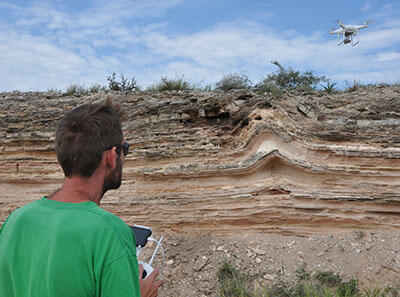
The technique allows computer-based geological interpretation and data extraction where conventional fieldwork may be impractical or unsafe. Drone-based techniques have the potential to substantially increase the amount of geological data that can be collected from field localities.
By using this data-driven approach, SwRI geologists will be able to capture the statistical properties of fault and fracture networks to study geological settings below ground. This will improve the understanding of hydrocarbon reservoirs, aquifers and potential sites for geological storage.
This effort uses automated feature detection to improve the efficiency, reliability and speed of digital data collection. Digital data are benchmarked and tested against traditional measurements to ensure that automated extraction provides robust results.
“We see this revolutionary technique as a way to supplement rather than replace traditional field-based data collection and analysis,” said Dr. David Ferrill, an SwRI geologist and Institute scientist. “This new approach enhances our already robust capabilities for field-based structural geology and quantitative structural analysis.”
Learn more at Geological Services.
First Mission to the Trojan Asteroids Reaches Milestones
The SwRI-led Lucy mission continues to move forward, passing two critical mission milestones in August in preparation for its October 2021 launch. This NASA Discovery Program class mission will be the first to explore the Trojans, ancient small bodies that share an orbit with Jupiter and hold important clues to understanding the early Solar System.
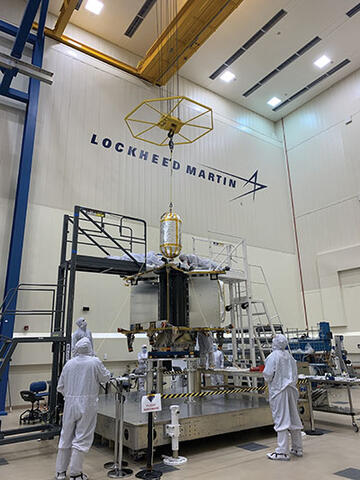
Courtesy of Lockheed Martin
Engineers install Lucy’s oxidizer tank into the spacecraft structure in the high bay at Lockheed Martin.
During this part of the mission’s life cycle, the spacecraft is completed, and the instruments are integrated into the spacecraft and tested. Next summer, the spacecraft will be sent to NASA’s Kennedy Space Center in Florida for integration with the launch vehicle.
“Each phase of the mission is more exciting than the last,” said Lucy Principal Investigator Dr. Hal Levison of SwRI. “While, of course, Lucy still has several years and a few billion miles to go before we reach our real goal — exploring the never-before-seen Trojan asteroids — seeing this spacecraft come together is just incredible.” Assembly, Testing and Launch Operations (ATLO) has begun at Lockheed Martin Space in Littleton, Colorado, in preparation for the launch window opening on October 16, 2021.
“We’ve had to revise the ATLO schedule to give the components affected by COVID-19 restrictions a bit more time before they will be integrated onto the spacecraft,” says Lucy Payload Deputy Project Manager John Andrews of SwRI. “Through a lot of hard work and ingenuity, the Lucy team is on schedule to ship the spacecraft to Kennedy Space Center as planned next July.”
After launch, Lucy will still have a long path ahead flying out to the distance of Jupiter to make close flybys past a record-breaking number of asteroids. The spacecraft will encounter the first of its eight targets, a main belt asteroid, in 2025. Lucy will reach the first of seven Trojan asteroids in 2027 and fly past the final binary pair in 2033.
ECTO-Lab Expands Capacity
SwRI added two new test stands to its Exhaust Composition Transient Operation Laboratory™ (ECTO-Lab), expanding its capacity to support Environmental Protection Agency and automotive industry initiatives to reduce harmful emissions.
This state-of-the-art, computer-controlled, multi-fueled burner system simulates engine exhaust conditions to conduct steady-state and transient evaluations, including the ability to rapidly “age” a wide range of emission control systems. These systems include a series of components that reduce the pollutants emitted in tailpipe engine exhaust.
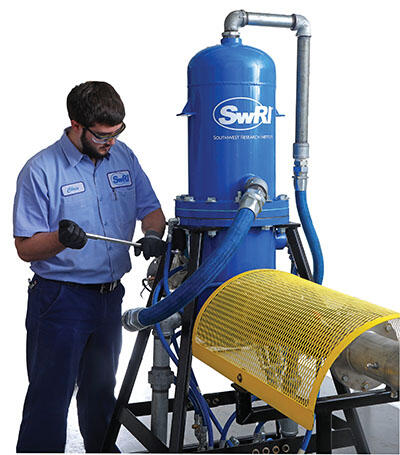
“ECTO-Lab data have demonstrated reduced cycle-to-cycle variation compared to engine dynamometer results, and performance data from ECTO-Lab-aged parts correlate well to field-aged parts,” said Dr. Cary Henry, an assistant director in SwRI’s Powertrain Engineering Division. “The ability to run accelerated aging on a bench stand could save industry millions of dollars, helping develop or improve technology to meet increasingly strict emissions regulations and increased targets for full useful life.”
SwRI has made significant technological advancements to ECTO-Lab hardware and software systems. The system is a critical instrument in evaluating the Diesel Aftertreatment Accelerated Aging Cycles (DAAAC) protocol, part of the EPA’s 2018 Cleaner Trucks Initiative to reduce NOx emissions from heavy-duty trucks. Once this validation is complete and the EPA grants approval, the DAAAC protocol will allow OEMs to simulate lifetime performance of diesel aftertreatment systems.
“Continued development of our ECTO-Lab technology helps us stay ahead of industry trends to evaluate full-size aftertreatment systems with the latest technologies for light-duty gasoline, heavy-duty diesel and natural gas engines,” Henry said. “Our latest generation of ECTO-Lab technology features a host of novel controls and instrumentation to improve the range of operation and controllability of stoichiometric and lean-burn systems.”
Learn more at Exhaust Composition Transient Operation Laboratory (ECTO-Lab).
Kansas DOT Selects ActiveITS
The Kansas Department of Transportation (KDOT) has selected SwRI’s ActiveITS Advanced Traffic Management System (ATMS) for statewide use under a \$1.4 million, three-year contract.
“The unique thing that SwRI’s ActiveITS brings to the table is the ability to share the costs of software development with other states and participate in a user group to share knowledge and features with other ITS professionals,” said Shari Hilliard, the KDOT project manager overseeing the deployment.
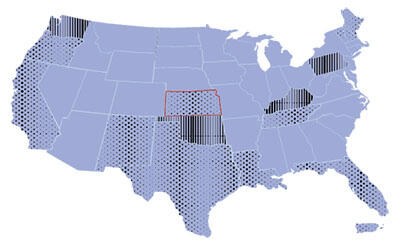
California, Oregon, Kansas, New Mexico, Texas, Louisiana, Tennessee, Florida, Maine, Vermont, New Hampshire and Puerto Rico are running ActiveITS in production. SwRI supports ATMS systems in Pennsylvania, Kentucky, Washington and Oklahoma.
Kansas is now among a dozen states and U.S. territories that use ActiveITS for traffic management and control of intelligent transportation system (ITS) devices such as signs and cameras. Through SwRI’s flexible licensing agreement, KDOT will get perpetual rights to freely use the software, providing the agency with more control over how it is deployed and customized, with support from SwRI engineers and knowledge shared from other state agencies.
“We are proud to support KDOT with a reliable and proven ATMS solution,” said Tucker Brown, the SwRI principal engineer leading the project. “ActiveITS will help Kansas get traffic information and incident response to the public as quickly as possible with integrated and streamlined data on congestion, event information, travel times and weather.”
ActiveITS provides coordinated real-time traffic, safety and weather information to motorists and enables collaboration between traffic managers and other agencies on accidents, construction and traffic flows. ActiveITS, which supports deployment on traditional servers, virtual machines or cloud environments, currently manages more than 13,000 consecutive highway miles in over 50 traffic management center deployments.
“This flexibility to operate in the cloud is especially relevant in the context of the COVID-19 pandemic or natural disasters,” added Dr. Steve Dellenback, vice president of SwRI’s Intelligent Systems Division. “We develop ITS solutions with the future in mind.”
Learn more at Intelligent Transportation Systems.
Unexpected Ultraviolet Aurora Discovered at a Comet
Data from SwRI-led instruments aboard ESA’s Rosetta spacecraft have helped reveal auroral emissions in the far ultraviolet around a comet for the first time.
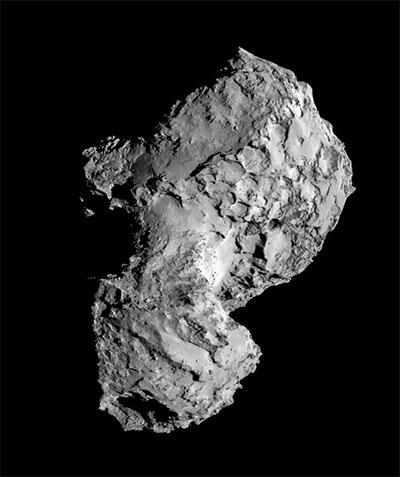
Courtesy of ESA/ROSETTA/MPS for OSIRIS TEAM MPS/UPD/LAM/IAA/SSO/INTA/UPM/DASP/IDA
At Earth, auroras are formed when charged particles from the Sun follow our planet’s magnetic field lines to the north and south poles. There, solar particles strike atoms and molecules in Earth’s atmosphere, creating shimmering curtains of colorful light in high-latitude skies. SwRI’s instruments, the Alice far-ultraviolet (FUV) spectrograph and the Ion and Electron Sensor (IES), aided in detecting these novel phenomena at comet 67P/Churyumov-Gerasimenko (67P/C-G). “I’ve been studying the Earth’s auroras for five decades. Finding auroras around 67P, which lacks a magnetic field, is surprising and fascinating,” said SwRI Vice President Dr. Jim Burch, who leads IES. “The IES instrument detected the electrons that caused the aurora.”
“Initially, we thought the ultraviolet emissions at comet 67P were phenomena known as ‘dayglow,’ a process caused by solar photons interacting with cometary gas,” said SwRI’s Dr. Joel Parker ,who leads the Alice spectrograph. “We were amazed to discover that the UV emissions are aurora, driven not by photons, but by electrons in the solar wind that break apart water and other molecules in the coma and have been accelerated in the comet’s nearby environment. The resulting excited atoms make this distinctive light.” Dr. Marina Galand of Imperial College London led a team that used a physics-based model to integrate measurements made by various instruments aboard Rosetta.
“By doing this, we didn’t have to rely upon just a single dataset from one instrument,” said Galand, who is the lead author of a Nature Astronomy paper outlining this discovery. “This enabled us to unambiguously identify how 67P/C-G’s ultraviolet atomic emissions form, and to reveal their auroral nature.”
Simulating Catastrophic Well Events
SwRI’s Gas Blowdown Facility has successfully recreated the intense conditions associated with high-pressure gas emergencies on offshore rigs, making it possible to test safety valves designed to withstand these conditions and prevent injury, loss of life and catastrophic oil spills.
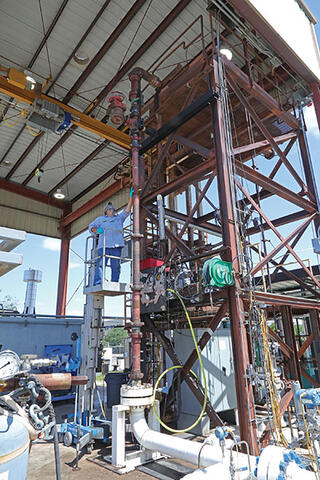
“Subsurface safety valves seal the production tubing when an emergency, such as failure of well control equipment, occurs,” said SwRI Research Engineer Maria Cortes. “They are installed as part of the upper production tubing and sit below the mouth of the well, beneath the ocean floor.”
SwRI has retrofitted its Gas Blowdown Facility to increase flow capacity and allow testing large diameter subsurface safety valves at higher-rate velocities.
“We simulate catastrophic well events,” Cortes said. “We want our clients to have more confidence in the capabilities of their safety equipment. This added testing capability could realistically prevent incidents that could cause a major oil spill.”
SwRI has been testing subsurface safety valves since 1975. SwRI’s Gas Blowdown Facility uses pure nitrogen gas, from a liquid source, to perform high differential pressure flow testing on client test articles. The facility has a gas source volume of 1,125 cubic feet and a maximum pressure of 3,000 pounds psi.
SwRI Achieves 20% Improvement in Vehicle Fuel Efficiency
A team led by Southwest Research Institute has applied connectivity and automation to achieve a 20% improvement in efficiency on a 2017 Toyota Prius Prime.
The program met efficiency goals without changing the powertrain or compromising emissions, safety or drivability. Typically, single-digit vehicle efficiency improvements are made by incrementally modifying components and control systems, often at a cost of millions of dollars.
“Vehicle connectivity and automation are already being used to effectively improve vehicle safety and driver convenience,” said Sankar Rengarajan, manager of SwRI’s Powertrain Controls Section. “For this program, we were able to tap into those existing data streams and put the information to use in a new way.”
Onboard sensing combined with data from vehicle-to-vehicle (V2V), vehicle-to-infrastructure (V2I) and vehicle-to-everything (V2X) technologies provided the information needed to predict driving environments and develop new technologies. The team achieved these benefits by developing next-generation vehicle dynamics and powertrain control software, designed to proactively use “look-ahead” information to anticipate vehicle power demands.
The new tools developed to meet these efficiency goals include eco-routing, eco-driving and power-split optimization. Using a mapping tool like Google Maps, drivers can set their destinations and see routes that may add a couple of minutes to their arrival, but that are more fuel-efficient. While the technology is appealing to the eco-minded consumer, for delivery and service fleets this 5–10% savings in fuel consumption can add up to millions of dollars in savings each year.
Eco-driving uses information from neighboring vehicles to minimize accelerations, while power-split optimization uses knowledge of routes and speeds to optimize battery and engine operations to more efficiently meet power demands.
The team included University of Michigan and Toyota Motor North America, and the project was sponsored by the Advanced Research Projects Agency – Energy (ARPA-E).
Learn more at Connected Powertrain.
Understanding Near-Earth Asteroid Bennu
WHAT CAN NASA EXPECT TO RETURN FROM THE ASTEROID’S SURFACE?
While NASA’s OSIRIS-REx spacecraft made history with a successful Touch-And-Go asteroid sample collection attempt, new research by SwRI scientists helped determine what the spacecraft can expect to return from the near-Earth asteroid Bennu’s surface. Three papers published online by Science discuss the color, reflectivity, age, composition, origin and distribution of materials on the asteroid’s rough surface. On October 20, the spacecraft descended to the asteroid’s boulder-strewn surface and touched the ground with its robotic arm to collect a sample of rocks and dust — marking the first time NASA has grabbed pieces of an asteroid for return to Earth. “Our recent studies show that organics and minerals associated with the presence of water are scattered broadly around Bennu’s surface, so any sample returned to Earth should contain these compounds and minerals,” said SwRI’s Dr. Vicky Hamilton, a coauthor on all three papers. “We will compare the sample’s relative abundances of minerals to those in meteorites to help determine the scenarios that best explain Bennu’s surface composition.”
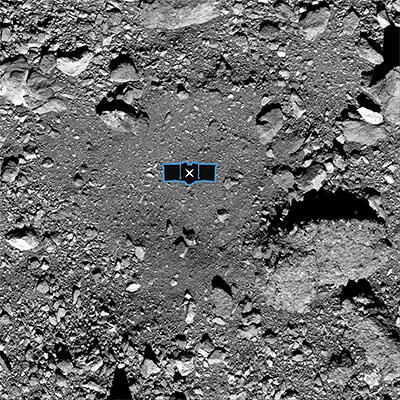
Courtesy of NASA/GODDARD/University of Arizona
SwRI scientists played a role in sample-site selection, including the primary site Nightingale shown here.
Asteroid Bennu is a dark, rubble pile held together by gravity and thought to be the collisional remnant of a much larger main-belt object. It’s had a rough-and-tumble life since being liberated from its much larger parent asteroid millions or even billions of years ago.
“Boulders strewn about near the sample site have bright carbonate veins,” Hamilton said. “This suggests that, early in Solar System history, at least some aqueously altered asteroids had considerably larger systems of percolating water than previously recognized.” The boulders on Bennu have diverse textures and colors, which may provide information about their variable exposure to micrometeorite bombardment and the solar wind over time. Studying color and reflectance data provides information about the geologic history of planetary surfaces. “Bennu’s diverse surface includes abundant primitive material potentially from different depths in its parent body plus a small proportion of foreign materials from another asteroid family littered about its surface,” said SwRI’s Dr. Kevin Walsh, a coauthor of one of the papers.
SAND-SIZED METEOROIDS PEPPER BENNU
An SwRI-led study indicates that observed particle ejections off the near-Earth asteroid Bennu are linked to surface impacts by sand-sized meteoroids as the object nears the Sun. SwRI’s Dr. William Bottke led the research team, which used data from NASA’s OSIRIS-REx mission. “While in orbit, the spacecraft has been sending images of Bennu back to Earth,” Bottke said. “One of the most significant things we’ve noticed is that the asteroid is frequently ejecting materials into space. Tiny rocks are just flying off its surface, yet there is no evidence that they are propelled by sublimating ice, as one might expect from a comet.”
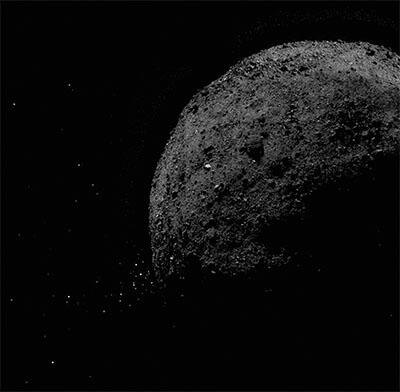
Courtesy of NASA/GODDARD/University of Arizona
Curiously, centimeter-scale pebbles fly off in the “afternoons” on Bennu. Determined to get to the bottom of these events, Bottke reached out to Althea Moorhead, a member of NASA’s Meteoroid Environment Office, which monitors and models meteoroid spacecraft hazards.
“Over the years, Althea and her team have built a computer model that determines the number of tiny particles impacting spacecraft,” Bottke explained. “We used this software to calculate the number of meteoroid impacts Bennu would face in its current orbit.”
Many meteoroids originated on comets. As comets approach the Sun, pieces break off and some comets even break apart completely as a consequence of solar heating, potentially providing a major source of meteoroids in the inner Solar System.
Models suggest that as Bennu approaches the Sun, it experiences a higher number of meteoroid impacts. These minuscule meteoroids hit Bennu with the force of a shotgun blast about once every two weeks, expelling significant amounts of pebble-sized debris from what is now thought to be a weak porous surface.

